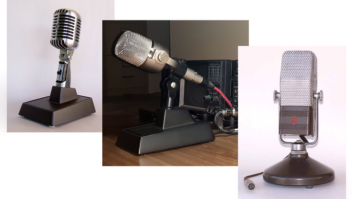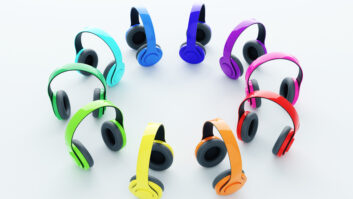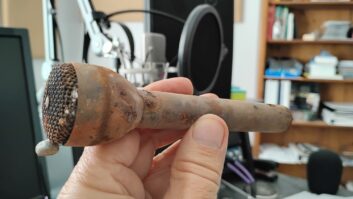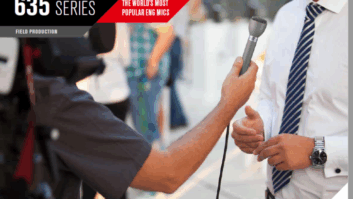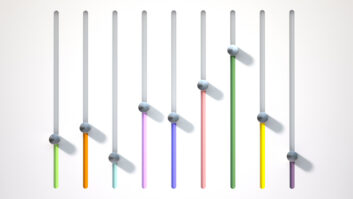We asked several Radio World contributors and colleagues to let us know which mics they go to at work.

Zach Sang of “Zach Sang and the Gang” visited WKNE. He sits next to the studio’s Electro-Voice RE620. Ira Wilner, chief engineer for Saga Communications, Keene, N.H.: “We use [Electro-Voice] RE20s and RE620s at all of the Saga cluster studios in Keene, N.H. — WKNE(FM), WINQ(FM),WSNI(FM),WKBK(AM) and WWZBK(AM). We sometimes use them on remotes along with [Shure] SM58s. The EV RE20s are workhorses. They always sound good, have decent built-in pop screens and nice directional patterns to reduce room tone. We use them on male and female voices.
“If I were a fine arts radio station I’d use Neumann condenser mics such as the U 87 or U 89 or their newer announcer mics, both condenser and dynamic, but only indoors.”
Al Peterson, production director, Radio America, and former RW Studio Sessions editor: “At Radio America, we have RE20s for on-air mics all over the house, connected to the requisite Symetrix 528 voice processors. The only changeup is in our video production suite, where we use a mix of Audio-Technica AT831and AT898 lavalier mics for on-camera talent and one MXL V67i FET condenser mic for the big-voiced narrations and VOs.”
AaronRead, director, IT/Engineering, Rhode Island Public Radio: “Rhode Island Public Radio uses four Electro-Voice RE20s in our studio. We also have one Neumann U 87A in our control room that our morning and afternoon anchors use. There’s a single Audio-Technica AT813a on a tabletop stand that’s frequently used by the guest on our ‘Political Roundtable’ segment.”
Kevin Larke, chief engineer, Midwest Communications Inc., Lansing, Mich.: “All of our air studios and production studios have Electro-Voice dynamic microphones, eight RE20s, seven RE27N/Ds and one RE320. We don’t have any condenser mics.
“I like the sound of the RE27N/Ds because they are brighter sounding than the older RE20s. Sometimes the RE20s sound a little muddy, especially with deeper male voices. We bought the black RE320 a couple years ago, and it sounds very good in our main voice tracking studio. It seems to sound somewhere in between the RE20 and RE27N/D as far as brightness. The RE-320 is priced lower, but it was disappointing to see it was made in China.

An Audio-Technica AT813a in use at Rhode Island Public Radio.
“All the other EV mics in our building were built in the U.S.A. back when EV was located in Buchanan, Mich. We also bought several RE309A shock mounts recently, and they were also made in China. The shock mounts were also made in Michigan previously.
“For remote broadcasts, we have a potpourri mix of different brand handheld dynamic mics. We have several Shure SM57s, an older EV RE50, and some low-cost Audio-Technica mics that we found in a 5 for $99 deal.”
Tom McGinley, director of engineering, CBS Radio Seattle and Radio World technical advisor: “KMPS(FM), a country music station, uses Shure SM7s in all studios. The PD requested those for their wide and forgiving sweet spot and natural sound.
“Classic rocker KZOK(FM) uses a Neumann U 87 on air and AKG 414s in production studios. The PD and jocks like the high-end clarity and ‘godlike’ sound they deliver.
“Jack FM KJAQ uses AT4500B condenser mics along with cheaper versions of the AKG 414 and AT4050s that deliver accurate and natural response.
“KFNQ(AM) CBS Sports Net uses Sennheiser MD-421/U dynamic mics — an old favorite for AM talk and sports.
“With a good mic processor that includes parametric EQ, gating and compression, almost any of the mics listed above can be made to sound very similar to any of the others. (Although, the U 87 stands in a class by itself.) We still like and use the Symetrix 528e mic processor. Easy to adjust and reliable.”

WAWZ’s Dawn Wheeler speaks into an Electro-Voice RE27.
Cris Alexander, director of engineering, Crawford Broadcast: “We use RE20s and EV 635s in control/production rooms. In talk studios we tend to use Shure SM58s because they’re just about impossible to overdrive and pop and because they are relatively deaf and don’t pick up extraneous noise from other people in the room. We also use SM58s in our remote kits for the same reasons.”
Curt Yengst, assistant engineer at WAWZ(FM): “Here at Star 99.1 we use Electro-Voice RE27s pretty much exclusively in our on-air and production studios. We have a few RE20s around as spares, and at our emergency studio, The Bunker. For remotes, we use Shure Beta SM58s. We like the REs because they sound great on just about everything we plug them into, they don’t need phantom power, and there’s not a beating they won’t take. Ditto the 58s — durable, reliable and idiot-proof.”
Michael LeClair, chief engineer, WBUR(FM) and Radio World Engineering Extra technical editor: “At our public radio stalwart, WBUR, we use the Neumann U 87A as our primary on-air microphone. The technical directors love them because you can set them up to work with just about anyone, and if there are many people in the room they can be set to figure 8 pattern to share the microphone.
“We also use the Neumann KM 183 and KM 184 microphones for instrument miking when we have musical acts in the studio.
“In the field we use a pair of Audio-Technica condenser microphones — the AT8031 handheld cardioid and the AT897 short shotgun. These microphones are our primary newsgathering types.”
Dan Slentz, former engineer and on-air host, including stops at WHIZ(AM/FM) and KERA(FM): “I’ve always been a fan of EV RE20 mics. I worked at one station that used Neumann U 87s and they eventually switched to 20s. I’ve tried a few others (even some new creations by nontraditional mic manufacturers) and find that a few of the ‘mic staples’ still seem to have the right sound.
“When Electro-Voice came out with the RE27N/D, I wanted to give that a shot … and I absolutely hated it. The different material (the N/D — neodymium) produced a ‘harsh sound.’
“However, when EV came out with the RE320 (and at a lower price), I expected myself to not like it at all, but was very pleasantly surprised by the quality. I have to say that it didn’t have the harshness of the 27, yet it had the full, rich sound of the 20 … but at a much better price.”
Mario Heib, contract engineer, KPCW(FM): We use Electro-Voice RE20s exclusively at KPCW, Park City, Utah. They are rugged and have little or no bass-boost proximity effect. We have them mounted in the Electro-Voice shockmounts, which are great at isolating table noise. Another nice feature of the RE20s is, that as dynamic microphones, they seem to be less sensitive to room and other noises. The main microphones use the Aphex Channel as a preamp and processor. The gating feature is great for reducing background noise.
What’s your mic of choice and why? Tell us in 200 words or less at [email protected], with Letter to the Editor in the subject field.
